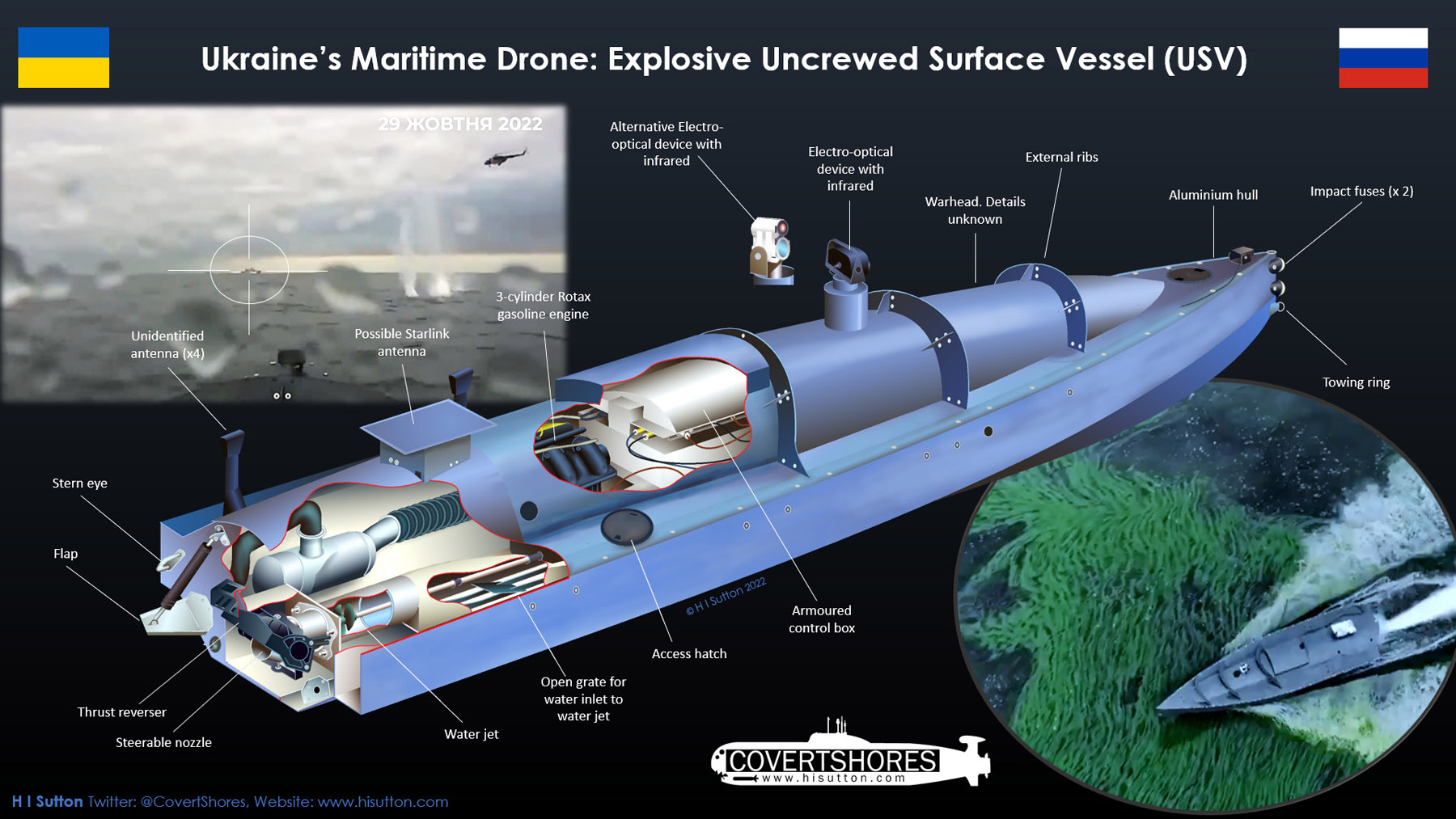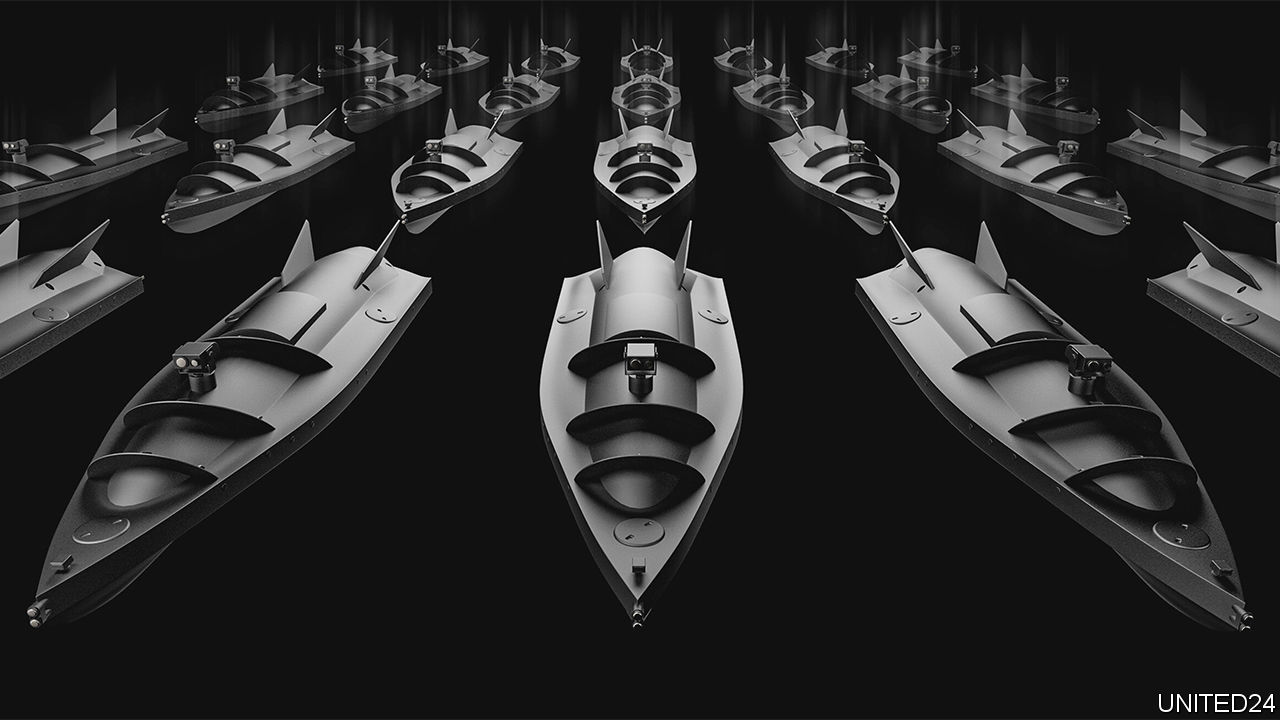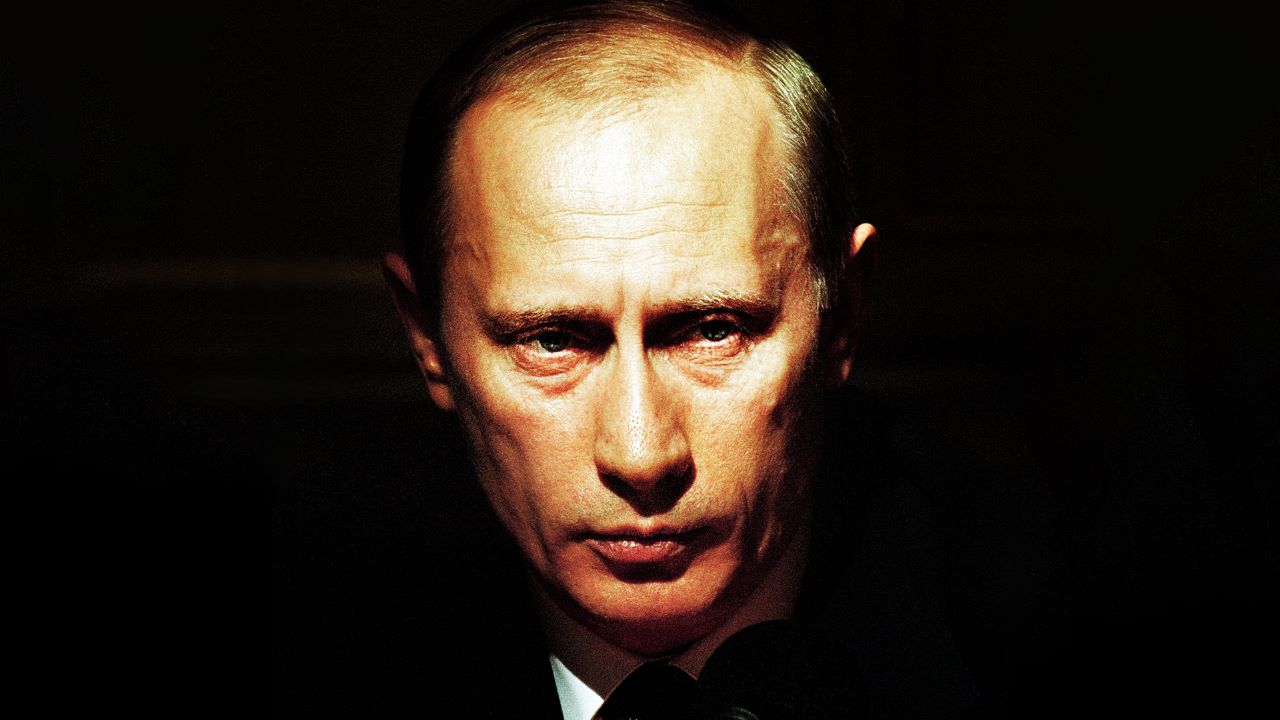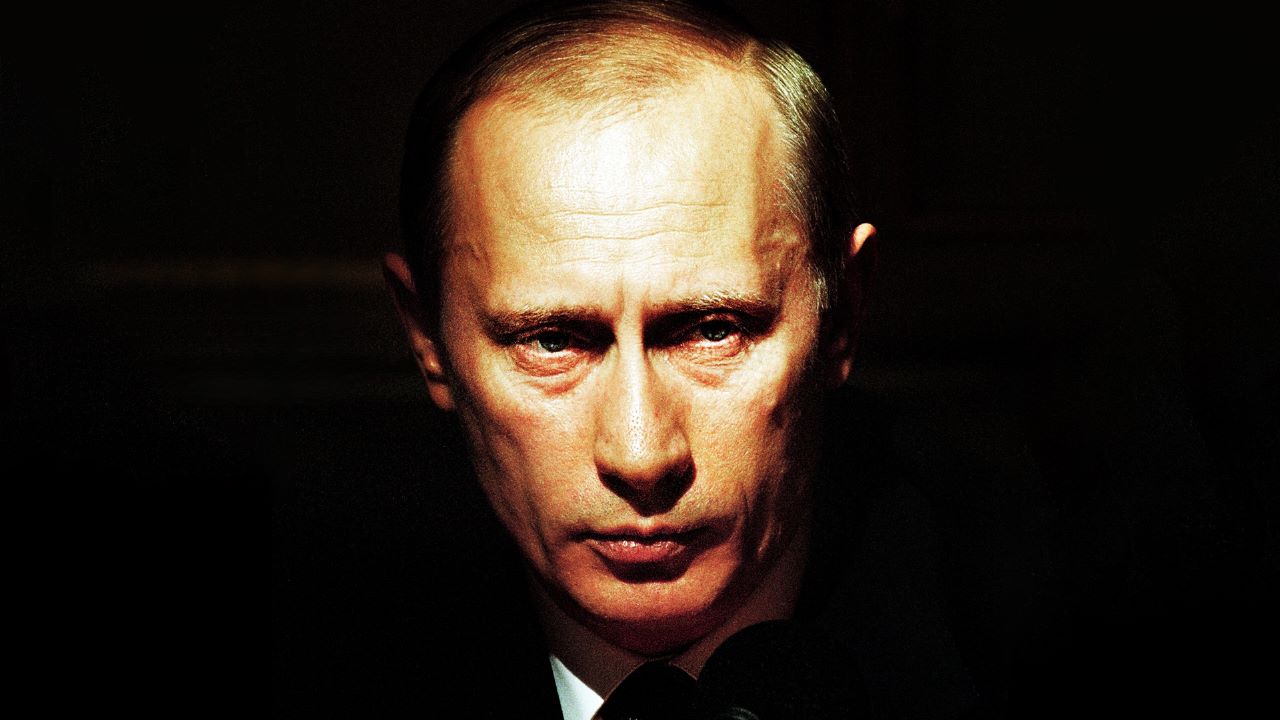Ukrainian sea drones are rapidly changing naval warfare. These unmanned vessels, ranging from small, expendable craft to more sophisticated autonomous systems, are proving surprisingly effective against larger, more expensive warships. This exploration delves into their technology, deployment, and global implications.
From their design and construction materials to their operational tactics and strategic impact, we’ll examine the capabilities and limitations of these innovative weapons. We’ll also look at the international response to their use and consider the future potential of Ukrainian sea drone technology.
Ukrainian Sea Drone Technology
Ukraine’s development and deployment of sea drones represent a significant shift in naval warfare capabilities. These unmanned systems offer a cost-effective and adaptable approach to maritime operations, showcasing innovative engineering and strategic thinking.
Types and Technological Advancements in Ukrainian Sea Drones

Ukraine utilizes a variety of sea drones, ranging from smaller, simpler models for reconnaissance to larger, more sophisticated platforms capable of carrying heavier payloads. These drones incorporate several technological advancements, including advanced navigation systems, sophisticated communication links, and durable construction materials designed to withstand harsh marine environments. Specific details on individual models remain largely classified for security reasons, but publicly available information suggests the integration of GPS, inertial navigation systems, and potentially even AI-assisted targeting for some models.
Comparison with Other Nations’ Sea Drone Capabilities
While precise specifications remain confidential, Ukrainian sea drones appear to be competitive with those of other nations in terms of adaptability and cost-effectiveness. Compared to larger, more expensive systems deployed by major naval powers, Ukrainian drones offer a flexible and easily deployable alternative. Their effectiveness in targeting high-value assets has garnered attention globally, highlighting the potential for asymmetric warfare strategies.
Materials Used in Construction
The construction materials used in Ukrainian sea drones are selected for durability, affordability, and ease of production. Common materials likely include reinforced fiberglass, high-density polyethylene, and other composites chosen for their resistance to saltwater corrosion and impact damage. The emphasis on readily available and relatively inexpensive materials is crucial, given the ongoing conflict and potential supply chain disruptions.
Ukraine’s naval capabilities have been significantly boosted by the development of their sea drones. These unmanned vessels are proving surprisingly effective in various operations. For more details on the innovative designs and applications, check out this informative resource on ukrainian sea drone technology. Understanding these drones is key to grasping Ukraine’s evolving naval strategy and its impact on the conflict.
Comparison of Ukrainian Sea Drone Models
| Model | Range (km) | Payload (kg) | Speed (knots) |
|---|---|---|---|
| Model A (Example) | 50-100 (Estimated) | 50-100 (Estimated) | 10-15 (Estimated) |
| Model B (Example) | 100-200 (Estimated) | 100-200 (Estimated) | 15-20 (Estimated) |
| Model C (Example) | 200+ (Estimated) | 200+ (Estimated) | 20+ (Estimated) |
Operational Deployment of Ukrainian Sea Drones

The strategic advantages of employing sea drones in naval warfare are numerous. They provide a cost-effective means to gather intelligence, conduct reconnaissance missions, and even execute attacks against enemy vessels. However, disadvantages include vulnerability to countermeasures and limitations in payload capacity compared to larger vessels.
Examples of Successful Deployments
While specific operational details are often kept confidential, reports indicate successful deployments of Ukrainian sea drones against Russian naval assets. These missions have demonstrated the drones’ effectiveness in disrupting enemy operations and causing significant damage. These successes highlight the tactical flexibility and asymmetric warfare potential of these relatively inexpensive platforms.
Tactics and Procedures
The tactics employed in using Ukrainian sea drones vary depending on the mission objective. This might include swarm tactics, utilizing multiple drones for coordinated attacks, or employing them as decoys to draw enemy fire. Procedures likely involve meticulous planning, pre-mission checks, and real-time monitoring and control of the drones throughout their operation.
Ukrainian sea drones are making waves in military tech, showcasing impressive capabilities. It’s a far cry from the dazzling spectacle of a drone show, like the one at the shanghai drone show , which highlights the artistic potential of drones. But both examples demonstrate the rapid advancement and diverse applications of drone technology; the Ukrainian drones are changing warfare, while the Shanghai show is changing entertainment.
Ultimately, both illustrate the power and versatility of this evolving technology.
Impact on Naval Combat Strategies
The use of Ukrainian sea drones has undeniably influenced naval combat strategies. Their cost-effectiveness and ease of deployment are forcing navies to rethink traditional approaches to naval warfare and consider countermeasures against such threats. The impact on naval doctrine is still evolving, but the trend points toward a greater emphasis on asymmetric warfare capabilities.
Typical Sea Drone Mission Steps
- Mission Planning and Target Acquisition
- Drone Preparation and Launch
- Navigation and Target Engagement
- Data Acquisition and Transmission
- Drone Recovery or Self-Destruct Sequence
- Post-Mission Analysis
Manufacturing and Supply Chain of Ukrainian Sea Drones
The development and production of Ukrainian sea drones involve a collaborative effort between various entities, including government agencies, private companies, and potentially international partners. Maintaining a reliable supply chain presents significant challenges, particularly considering the ongoing war and international sanctions.
Challenges in Maintaining the Supply Chain

The war in Ukraine has significantly impacted the availability of certain components and materials. International sanctions on Russia have also created disruptions in the supply chain. Overcoming these challenges requires innovation, adaptation, and potentially the exploration of alternative sourcing options for critical components.
Impact of International Sanctions
International sanctions imposed on Russia have undoubtedly affected the procurement of certain components for Ukrainian sea drones, necessitating the exploration of alternative suppliers and potentially leading to adjustments in the design and production process to utilize readily available materials.
Adaptation to Changing Technological Landscapes, Ukrainian sea drone
The Ukrainian drone program demonstrates a remarkable ability to adapt to evolving technological landscapes. Continuous innovation and integration of new technologies are crucial for maintaining operational effectiveness and countering emerging threats.
International Implications and Responses to Ukrainian Sea Drone Use
The deployment of Ukrainian sea drones has generated varied international responses. Some countries express concern about the potential for escalation, while others view it as a legitimate response to aggression. The legal frameworks governing the use of autonomous weapons systems at sea are still developing and subject to ongoing debate.
Ukrainian sea drones are proving to be surprisingly effective, showcasing the potential of smaller, less expensive naval tech. It’s a far cry from the dazzling spectacle of a coordinated drone display, like the one you can check out at the china new year drone show , but both highlight the diverse applications of drone technology. Ultimately, the impact of Ukrainian sea drones might be just as significant, though in a very different way.
Reactions of Different Countries
The international community’s reaction to Ukrainian sea drone usage is complex and multifaceted. Some nations express support for Ukraine’s right to self-defense, while others express concern over the potential for unintended consequences and the broader implications for international law. This highlights the lack of universally accepted guidelines governing the use of autonomous weapons systems in warfare.
Potential for Escalation or De-escalation
The use of sea drones could potentially escalate or de-escalate conflicts depending on the context and scale of their deployment. Targeted attacks against specific assets could be viewed as a proportionate response, while large-scale attacks might be seen as an act of aggression, leading to escalation. The potential for unintended consequences also underscores the need for careful planning and control.
International Legal Frameworks
International legal frameworks governing the use of autonomous weapons systems at sea are still evolving. Existing laws of armed conflict apply, but the specific legal implications of using autonomous systems require further clarification and international consensus. The potential for unintended escalation and the ethical considerations surrounding autonomous weapons systems necessitate a comprehensive review and update of existing legal frameworks.
Scenario: Future Uses and Implications
A plausible future scenario involves the increased sophistication and autonomy of Ukrainian sea drones. This could include the integration of AI for improved target recognition and decision-making, as well as the development of drones capable of carrying larger payloads and operating over longer ranges. This enhanced capability could significantly alter naval warfare, requiring navies to adapt their strategies and invest in countermeasures.
Future Developments and Potential of Ukrainian Sea Drone Technology

The future of Ukrainian sea drone technology holds significant potential for innovation and improvement. Increased autonomy, enhanced payload capacity, and the integration of advanced AI are likely areas of focus for future development.
Potential Improvements and Innovations
Future Ukrainian sea drones may incorporate advanced AI algorithms for improved target recognition and autonomous decision-making. Increased endurance and range are also likely, allowing for longer deployments and wider operational areas. Enhanced communication systems will improve real-time control and data transmission capabilities.
Expansion of Capabilities
Future models could feature significantly increased payloads, allowing for the deployment of larger weapons or sensors. Greater autonomy will reduce reliance on human operators and enable more complex missions. Improvements in stealth technology will enhance survivability and effectiveness in hostile environments.
Integration of AI and Machine Learning
The integration of AI and machine learning will be crucial in enhancing the autonomy and effectiveness of future Ukrainian sea drones. AI-powered systems could improve target identification, navigation, and decision-making, potentially leading to more precise and efficient operations.
Hypothetical Advanced Ukrainian Sea Drone
Imagine a sleek, low-profile drone, constructed from advanced composite materials for enhanced stealth and durability. It is equipped with advanced sensors for target acquisition and environmental monitoring, including sonar, radar, and electro-optical systems. The drone boasts a significantly extended range, allowing for prolonged missions far from shore. It is capable of carrying a heavier payload, including a variety of weapons or specialized equipment, and incorporates sophisticated AI for autonomous navigation, target identification, and engagement.
The drone’s communication system is highly resistant to jamming and allows for secure, real-time data transmission. It also incorporates advanced countermeasures to evade detection and neutralization.
Last Point
Ukrainian sea drones represent a significant shift in naval power dynamics. Their relatively low cost, adaptability, and surprising effectiveness challenge traditional naval strategies. While their future development remains to be seen, their current impact is undeniable, forcing a reevaluation of maritime defense and offense across the globe. The ongoing evolution of these drones promises further innovation and a continued impact on global security.
FAQ Resource: Ukrainian Sea Drone
What are the main limitations of Ukrainian sea drones?
Current limitations include range, payload capacity (for larger drones), vulnerability to countermeasures (like jamming or electronic warfare), and dependence on reliable communication links.
How are Ukrainian sea drones funded?
Funding likely comes from a combination of government resources, international aid, and potentially private investment.
Are there any ethical concerns surrounding the use of Ukrainian sea drones?
Ethical concerns center around the autonomous nature of some drones and the potential for unintended harm or escalation of conflicts.
What types of sensors do Ukrainian sea drones typically use?
Likely sensors include cameras (visual and infrared), radar, sonar, and GPS for navigation and target acquisition.
